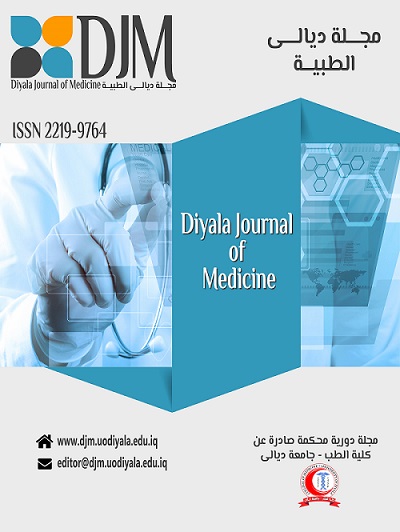Abstract
Abstract
Background: A common metabolic disorder during pregnancy is gestational
diabetes mellitus (GDM). It is linked to insulin resistance and impaired
glucose tolerance. The role of neudesin, a regulatory peptide hormone
involved in glucose metabolism, as a potential biomarker for GDM remains
unclear.
Objectives: To assess Neudesin's predictive value for GDM and evaluate its
correlation with insulin resistance indices and glycemic indicators.
Patients and Methods: This case-control study was conducted in Baghdad,
Iraq, from January to July 2025 at the Department of Chemistry, College of
Science for Women, University of Baghdad, in collaboration with the
Department of Obstetrics and Gynecology at Al-Yarmouk Teaching Hospital.
Eighty healthy controls and 120 women with GDM were included. Serum
Neudesin, fasting blood glucose (FBG), insulin, HOMA-IR, HbA1c, TyG
index, and TyG-BMI index were evaluated.
Results: Women with GDM had significantly higher serum Neudesin levels
compared to controls (2.372 ± 0.36 ng/mL vs. 0.919 ± 0.156 ng/mL, p<0.001).
Neudesin levels were positively correlated with BMI, FBG, HbA1c, insulin,
HOMA-IR, and TyG indices (p<0.001). Logistic regression identified
neudesin as an independent predictor for GDM. ROC analysis showed high
diagnostic accuracy (AUC = 0.986), with a cut-off value of 1 1185 ng/ml,
which yielded 100% sensitivity and 86.7% specificity.
Conclusion: Circulating neudesin concentrations are markedly higher in
individuals with GDM and show a strong correlation with the degree of insulin
resistance and poor glycemic control. Neudesin may serve as a promising
diagnostic biomarker and potential target for early identification and
management of GDM.
Background: A common metabolic disorder during pregnancy is gestational
diabetes mellitus (GDM). It is linked to insulin resistance and impaired
glucose tolerance. The role of neudesin, a regulatory peptide hormone
involved in glucose metabolism, as a potential biomarker for GDM remains
unclear.
Objectives: To assess Neudesin's predictive value for GDM and evaluate its
correlation with insulin resistance indices and glycemic indicators.
Patients and Methods: This case-control study was conducted in Baghdad,
Iraq, from January to July 2025 at the Department of Chemistry, College of
Science for Women, University of Baghdad, in collaboration with the
Department of Obstetrics and Gynecology at Al-Yarmouk Teaching Hospital.
Eighty healthy controls and 120 women with GDM were included. Serum
Neudesin, fasting blood glucose (FBG), insulin, HOMA-IR, HbA1c, TyG
index, and TyG-BMI index were evaluated.
Results: Women with GDM had significantly higher serum Neudesin levels
compared to controls (2.372 ± 0.36 ng/mL vs. 0.919 ± 0.156 ng/mL, p<0.001).
Neudesin levels were positively correlated with BMI, FBG, HbA1c, insulin,
HOMA-IR, and TyG indices (p<0.001). Logistic regression identified
neudesin as an independent predictor for GDM. ROC analysis showed high
diagnostic accuracy (AUC = 0.986), with a cut-off value of 1 1185 ng/ml,
which yielded 100% sensitivity and 86.7% specificity.
Conclusion: Circulating neudesin concentrations are markedly higher in
individuals with GDM and show a strong correlation with the degree of insulin
resistance and poor glycemic control. Neudesin may serve as a promising
diagnostic biomarker and potential target for early identification and
management of GDM.
Keywords
Biomarker.
Gestational diabetes mellitus
insulin resistance
Neudesin
